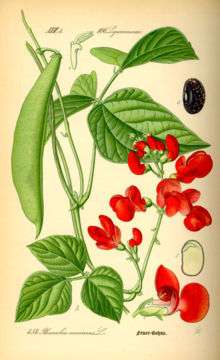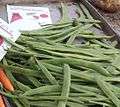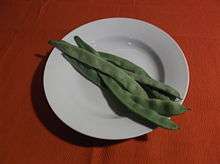Phaseolus coccineus
Phaseolus coccineus, known as runner bean,[2] scarlet runner bean,[2] or multiflora bean,[2] is a plant in the legume family, Fabaceae. Another common name is butter bean,[3][4][5] which, however, can also refer to the lima bean, a different species.
| Phaseolus coccineus | |
|---|---|
 | |
| Scientific classification | |
| Kingdom: | Plantae |
| Clade: | Tracheophytes |
| Clade: | Angiosperms |
| Clade: | Eudicots |
| Clade: | Rosids |
| Order: | Fabales |
| Family: | Fabaceae |
| Genus: | Phaseolus |
| Species: | P. coccineus |
| Binomial name | |
| Phaseolus coccineus | |
| Synonyms[1] | |
|
List
| |
It is grown both as a food plant and an ornamental plant.
Description
This species originated from the mountains of Central America. It was most likely cultivated in the highlands of Mexico and Guatemala around 2000 BC.[6] Most varieties have red flowers and multicolored seeds (though some have white flowers and white seeds), and they are often grown as ornamental plants. The vine can grow to 3 m (9 ft) or more in length.[7]
It differs from the common bean (P. vulgaris) in several respects: the cotyledons stay in the ground during germination, and the plant is a perennial vine with tuberous roots (though it is usually treated as an annual).
The knife-shaped pods are normally green; however, there are very rare varieties bred by amateurs that have very unusual purple pods. An example of such a purple-podded runner bean is 'Aeron Purple Star'.[8]
Runner beans have also been called "Oregon lima bean",[9] and in Nahuatl ayocotl or in Spanish ayocote. Runner beans, like all beans, contain the toxic protein phytohaemagglutinin and thus should be cooked well before eating.[10]
Usage
In the US, in 1978, the scarlet runner was widely grown for its attractive flowers primarily as an ornamental.[11] Since that time, many US gardeners have adopted the bean as a regular member of the vegetable garden. The flower is known as a favourite of hummingbirds. In the UK – where the vegetable is a popular choice for kitchen gardens and allotments – the flowers are often ignored, or treated as an attractive bonus to cultivating the plant for the beans.
The seeds of the plant can be used fresh or as dried beans. The pods are edible whole while they are young and not yet fibrous. The starchy roots are still eaten by Central American Natives.
The beans are used in many cuisines. It is a popular side vegetable in British cuisine. A variety named 'Judión de la Granja' producing large, white, edible beans is cultivated in San Ildefonso, Spain.[12] It is the basis of a Segovian regional dish also named Judiones de la Granja, in which the beans are mixed with pig's ears, pig's trotters, and chorizo, amongst other ingredients.[13]
In Greece, cultivars of the runner bean with white blossom and white beans are known as fasolia gigantes (φασόλια γίγαντες). They are grown under protective law in the north of Greece within the regions of Kato Nevrokopi, Florina and Kastoria.[14] The beans have an important role in Greek cuisine, appearing in many dishes (such as Gigandes plaki). In English, they are sometimes colloquially referred to as elephant beans.[15][16] In Austria the coloured versions are cultivated and served as "Käferbohnen" ("beetle-bean"), a dish made of the dry beans with pumpkin seed oil. It is considered a typical dish of regional Austrian cuisine, but dried runner beans are also consumed to a small extent in Germany.
Greece and northern Africa are the sources of pods of the runner beans sold as "green beans" in European markets during the cold period. The pods can be identified by their big size and the rougher surface.
- 'Aeron Purple Star' (not available commercially)[8]
- 'Black Runner'
- 'Butler'
- 'Case Knife'
- 'Hammond's Dwarf'
- 'Painted Lady'
- 'Pickwick Dwarf'
- 'Polestar'
- 'Scarlet Runner'
- 'White Dutch Runner'
P. coccineus subsp. darwinianus is a cultivated subspecies, commonly referred to as the botil bean in Mexico.
The related species considered most useful for interbreeding with P. coccineus to increase its genetic diversity are P. dumosus and P. vulgaris.[18]
 Runner (stick) beans for sale on a UK market stall
Runner (stick) beans for sale on a UK market stall Seeds of 'Scarlet Emperor'
Seeds of 'Scarlet Emperor' Spanish variety Judión de la Granja
Spanish variety Judión de la Granja Austrian "Käferbohnen salad" that contains pumpkin seed oil and sliced onions
Austrian "Käferbohnen salad" that contains pumpkin seed oil and sliced onions
.jpg) Giant beans, a Mediterranean side dish: cooked runner beans in tomato sauce.
Giant beans, a Mediterranean side dish: cooked runner beans in tomato sauce.
References
- "The Plant List: A Working List of All Plant Species".
- "Phaseolus coccineus". Germplasm Resources Information Network (GRIN). Agricultural Research Service (ARS), United States Department of Agriculture (USDA). Retrieved 16 December 2017.
- M. Brink; G. Belay, eds. (2006). Cereals and Pulses. Plant Resources of Tropical Africa 1. PROTA. p. 139. ISBN 90-5782-170-2.
- "Phaseolus coccineus L.". Strand Memorial Herbarium. University of Minnesota. 2016. Retrieved September 27, 2017.
- "Phaseolus coccineus (runner bean)". Invasive Species Compendium. CABI. Retrieved September 26, 2017.
- Pearman, Georgina (2005). Prance, Ghillean; Nesbitt, Mark (eds.). The Cultural History of Plants. Routledge. p. 146. ISBN 0415927463.
- Scarlet Runner Beans – GROWS 10' TALL!! Ancient Beans for Cool Weather. YouTube. 18 August 2012.
- "Aeron Purple Star Runner Bean Seeds". Retrieved 2014-09-13.
- "The Beekeeping Resource Leader – Bee Culture Magazine". Bee Culture. Archived from the original on 2011-07-07. Retrieved 2010-08-16.
- "Beans! Beans! The Poisonous Fruit! - Dave's Garden". davesgarden.com. Retrieved 2018-07-24.
- The Two Hour Garden The Sunday Times (1978)
- "Judiones". Judiones de la Granja. 7 September 2008. Retrieved 8 November 2008.
- "Judiones de La Granja recipe". Judiones de la Granja. 22 June 2008. Retrieved 8 November 2008.
- "DOOR". europa.eu.
- "Greek Elephant Beans". Men's Health. 2016-03-31. Retrieved 2016-12-26.
- "Baked elephant beans | Toronto Star". thestar.com. Retrieved 2016-12-26.
- Phaseolus coccineus. FloriData.
- "The Harlan and de Wet Crop Wild Relative Inventory – chapter: Phaseolus coccineus". Global Crop Diversity Trust, the Millennium Seed Bank of the Royal Botanic Gardens Kew, and the Government of Norway. Retrieved 12 Sep 2013.
External links

